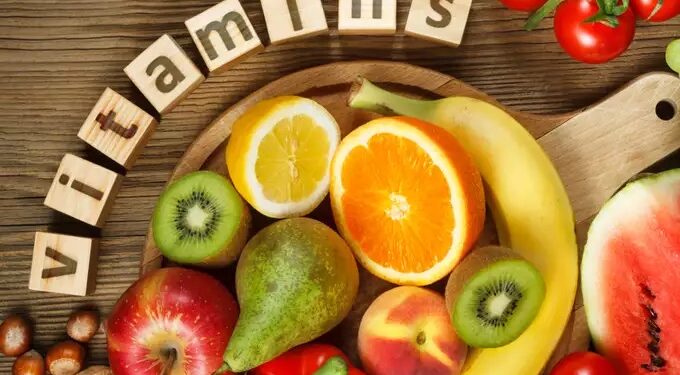Types of vitamins is a crucial nutrient and natural substance which organisms require in a restricted total up to support typical physiological activity. The body isn’t able to synthesize vitamins quickly enough to satisfy everyday requirements. So, you need vitamins in your diets, and when any of them is missing from your diet plan, it will lead to a shortage.
Types Of Vitamins And Their Sources And Deficiency\
In this article, you can know about types of vitamins here are the details below;
Kinds of Vitamins
There remain in total 13 vitamins which the body requires. These 13 vitamins can be divided into two types:
1.Water-Soluble Vitamins: (Vitamin B1, B2, B3, B5, B6, B7, B9, B12, and C).
2.Fat-Soluble Vitamins: (Vitamin A, D, E, and K).
Water-Soluble Vitamins.
These vitamins are easily liquified in water and typically are excreted from the human body. The urinary output anticipates highly that you have taken in the vitamin. These vitamins are not stored easily, so day-to-day intake is essential. Bacteria synthesize numerous water-soluble vitamins. You can also check best multivitamin for men.
Vitamin B1/ Thiamin:
Sources: Asparagus, Sunflower seeds, lettuces, black beans, mushrooms, lentils, navy beans, peas, spinach, lima beans, pinto beans, Brussels sprouts, eggplants, tuna, tomatoes, soybeans, and entire wheat are sources of vitamin B1 or Thiamin.
Deficiency: Toxicity is unknown. Weakness in extremities, burning feet, swelling, fast heart rate, nausea, anorexia, gastrointestinal problems, and tiredness are the signs of vitamin B1 shortage.
Vitamin B2/ Riboflavin:
Sources: Soybeans/tempeh, almonds, spinach, mushrooms, yoghurt, whole wheat, mackerel, liver, and eggs are sources of vitamin B2 Riboflavin. The threat of breaking DNA hair in chromium’s existence may increase because of excess Riboflavin. Riboflavin consumption in high-dose intensifies urine colour to flavinuria or a bright yellow colour which is safe.
Deficiency: Sores, fissures and cracks at the corners of lips and mouth, conjunctivitis, dermatitis, glossitis of tongues, photophobia, anxiety, fatigue, and anorexia nervosa are the signs of vitamin B2 shortage.
Vitamin B3/ Niacin:
Sources: Asparagus, mushrooms, wild rice, peanuts, corn, sweet potato, green leafy vegetables, potato, barley, lentil, almonds, carrots, turnips, celery, chicken-meat, peaches, salmon, and tuna are the sources of vitamin B3 or Niacin. There is no adverse impact of natural Niacin or which you receive from food. Supplemental Niacin might result in itching, impaired glucose tolerance, flushing of the skin and gastrointestinal problem. Intaking 750 mg Niacin supplement daily for fewer than three months triggers damage to the liver cell. Nicotinamide in high dosage may cause liver toxicity and sickness.
Shortage: Diarrhea, dermatitis, stomatitis, and dementia are symptoms of vitamin B3 deficiency.
Vitamin B5/ Pantothenic acid:.
Sources: Lentils, broccoli, avocado, split peas, mushrooms, entire wheat, sunflower seeds, sweet potato, eggs, cauliflower, strawberries, squash, liver and green leafy veggies are the sources of vitamin B5 or Pantothenic acid. A high dosage of Pantothenic acid supplements may cause diarrhoea, heartburn, and nausea.
Shortage: Deficiency of vitamin B5 is very rare. In case of serious malnutrition, tingling of the feet is discovered.
Vitamin B6/ Pyridoxine:
Sources: Brown rice, whole wheat, sunflowers seeds, green leafy vegetables, garbanzo beans, potato, trout, banana, tomatoes, spinach, walnuts, avocado, peanut butter, lima beans, salmon, chicken meat, and bell pepper’s are the sources of vitamin B6 or Pyridoxine. Vitamins B6 supplements, if taken in high doses, may trigger neurological issues.
Shortage: Glossitis, cheilosis, dermatitis, stomatitis, nervous system conditions, confusion, sleeplessness, anxiety, uneasiness, interference with muscles supplying nerves, problems in these muscles’ movement, irritation and anaemia are the signs of vitamin B6 deficiency. Prenatal deficiency may trigger blood disorders and mental retardation for the newborn.
Vitamin B7/ Biotin:
Sources: Most nuts, green leafy veggies, avocado, entire grain bread, cauliflower, raspberries, papaya, carrots, eggs, salmon and banana are the source of vitamin B7 or Biotin. It has no harmful result. Vitamin B7 shortage is uncommon among people. Consuming raw egg whites for a long period might lead to a shortage of biotin. Protein avidin, present in egg whites, prevents biotin’s absorption in the body.
Vitamin B9/ Folic acid:
Sources: You can get Folate from various healthy foods. Folate’s synthetic form is folics acid which is utilized in commercially ready fortified foods and supplements. Asparagus, green leafy vegetables, Brussels sprouts, broccoli, citrus fruits, spinach, black-eyed peas, entire grains, great northerns beans, green peas, baked beans, peanuts, avocados, tomato juice, lettuces, papaya, banana, and organ meats are the sources of vitamin B9 or Folate.
Shortage: Folate from health foods has no hazardous result. Shortage of either Folic acid or vitamin B12, or both can cause megaloblastic anemia. Folic acid in large doses offered to a client with an undiagnosed shortage of vitamin B12 can treat megaloblastic anemia without curing the shortage of vitamin B12.
Folate shortage is associated with some cancers and flaws of neural tubes. Megaloblastic/macrocytic anemia, Leukopenia, sprue, thrombocytopenia, weight-loss, weak point, diarrhea and inflammation and cracking of mouth and tongues are the symptoms of vitamin B9 or folic acid shortage. Preterm shipment and low birth weight can be caused in pregnancy due to vitamin B9 deficiency.
Vitamin B12/ Cobalamin:.
Sources: Vitamin B12 is soaked up into the blood after it has been integrated with intrinsic factors. The body can store a year’s needed vitamin B12, but you should still consume it regularly. Germs fermentation produces vitamin B12, so it is absent in plant foods of a higher order. Liver, eggs, strengthened cereals, salmon, trout, haddock, and tuna are sources of vitamin B12 or Cobalamin.
Neither food nor supplement kind of this vitamin has any toxic effect. Since an extremely little amount is absorbed through the oral path, the toxicity’s likelihood is low.
Deficiency: Sprue, neurological problems, and pernicious anemia are the main symptoms of vitamin B12 shortage.
Vitamin C/ Ascorbic acid:.
Sources: Bell pepper, guava, kiwi, orange, strawberries, grapefruit, Brussels sprouts, papaya, cantaloupe, broccoli, sweet potato, kale, cauliflower, parsley, and lemon-juice are the sources of vitamin C or Ascorbic acid. Many data explain that vitamin C consumption of approximately 10 grams daily is safe. 2 grams of vitamin C or more daily can lead to diarrhea. Large consumption of this vitamin can cause rebound scurvy, kidney stones, excess iron absorption, increased oxidative tension, oral enamel’s disintegration, and vitamin B12 deficiency.
Deficiency: Gum infections, bruising, dental-cavities, lethargy, tissue swelling, bleeding gums, dry skins and hair, hair loss, dry eyes, pitting edema, bone fragility, postponed wound healing, anemia, and joint pain are symptoms of this vitamin deficiency.
Fat-Soluble Vitamins:
Lipids (fats) soak up these vitamins through the intestine. Fat-soluble vitamins tend to build up in the body, so they have more likelihood to cause hypervitaminosis than water-soluble vitamins. Also check mental health services.
Vitamin A/ Retinoids:
Sources: Carrots, pumpkin, green leafy veggies, sweet potato, cantaloupe, squash, Chinese cabbage, bell-pepper, eggs, beef, and peaches are the sources of vitamin-A. The body converts carotenoids into Retinol. Preformed vitamin A (not the plant carotenoid) intake in high dosage triggers Hypervitaminosis A, headache, nausea, anorexia nervosa, tiredness, dry skin, and lightheadedness. During pregnancy, excess consumption can result in abnormality.
Deficiency: Dry/rough skin, problem seeing in low light are the signs of a shortage of this vitamin.
Vitamin D:
Sources: Sunlights, mushrooms, fortified foods, mackerel, salmon, tuna, eggs, and sardines are the sources of vitamin-D. Chronic supplements of this vitamin triggers Hypervitaminosis D, an increase of calcium levels in the blood, loss of appetite, vomiting, queasiness, extreme urination, extreme thirst, weak muscle point, itching, disorientation, and joint discomfort. Vitamin D deficiency causes warped bones, rickets, soft teeth, and retarded growth in kids and softened bones, osteomalacia, tooth decay, and spontaneous fractures in grownups.
Shortage: Infants or elderly who have minimal sun exposure, individuals with dark skin, FMS (Fat Malabsorption Syndromes), seizure disorders, kidney failures, and inflammatory bowel illness are at threat for this shortage.
Vitamin E/ Tocopherol:.
Sources: Almonds, greens leafy vegetables, olives, sunflower seeds, many nuts, blueberries, many seeds, avocado, and tomatoes are the sources of vitamin-E or Tocopherol. Negative effects are minimal in grownups who take supplements in less than 2000mg per day. Babies are more likely to have impaired blood clot in case of overdosages.
Deficiency: Vitamin -E deficiency can be seen only in individuals suffering from serious poor nutrition.
Vitamin K:
Sources: Asparagus, Brussels sprouts, broccoli, green beans, green leafy vegetables, green peas, parsley, carrots, and watercress are the sources of vitamin K. This vitamin may have interference with glutathione. The Toxic result of high dosages is unknown.
Deficiency: Anemia, haemorrhage or tendency to bleed are the symptoms of Vitamin K shortage.





